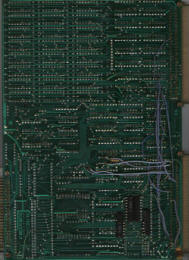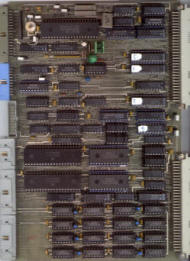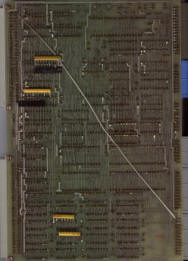Microtrol
Not much is known about this 8-bit portable
microcomputer. It's a device with built-in green CRT monitor and
keyboard. Presence of ROM (?EPROM?) programming socket reminds old
industrial machines. As primary storage a 3.5" floppy disk is used by
built-in drive. Today the manufacturer is still in market selling
industrial automation systems, but not much is known about this
computer.
The machine is made of parts existing in market in early 1980s. Keyboard
is a Cherry terminal keyboard, monitor is also a component, power supply
comes from some industrial system. The CPU is implemented on two
Double-Euro sized boards. First one is a 48kB German (West Germany)
computer called Eltec Eurocom 2 (v. 5, sometimes mentioned as
"Bystronic"), this computer was used in early 1980s in industrial
applications and for driving sound recording/sampling/synthesizing
equipment. Second board contains floppy disk drive controller,
additional S-RAM and secondary RAM memory. Secondary RAM memory is
unusually large for such computer (512kB) so I think that it's a RAM
disk for storing some data. S-RAM memory may be used as a buffer for
some on-board controllers.
| Manufacturer | Microtrol | |
| Origin | West Germany (CPU board) | |
| Year of unit | 1985 | |
| Year of introduction | ?1985? | |
| End of production | ?1985? | |
| CPU | Motorola 6809 | |
| Speed | 1,33MHz | |
| RAM | 48kB CPU +16kB S-RAM + 512kB ?RAMdisk? |
|
| ROM | 4kB | |
| Colors: | 2 | |
| Sound: | None | |
| OS: | Monitor, ??? | |
| Display modes: | Text: 80x24? ?84x25? ?512x256 graphics? |
|
| Media: | Built-in 3.5" FDD | |
|
Power supply: |
||
|
Built-in switching power supply |
||
| I/O: | Built-in keyboard Built-in ROM programming socket ?Parallel port? ?Serial port? ??General purpose IO port?? One DB9 connector - unknown. |
|
| Possible upgrades: | ?? | |
| Software accessibility: | Probably impossible |
My unit is in working condition but I have no system floppy disk to boot it. It works quite well as for its age. The serial number is 18, so it was not manufactured in bigger quantity. By components age it was estimated that year of manufacturing is probably 1985 (newest component - floppy disk drive).
Here are good resolution scans of boards (CPU board and
then FDD controller board) for diagnostic purposes:




| Contents: | Starting | Links |
Starting:
After powering on using front-panel switch, the CRT
should light up and disk insertion message can be seen. Pressing a key
makes computer try to boot from floppy. If no floppy is present, the
message will be redisplayed.
If any floppy is placed in drive, the system will try to boot from it.
It requires floppy disk with its OS, so from normal floppy it won't
boot, passing control to on-ROM monitor program. The following commands
are accessible (not all commands are listed here):
- L - prints serial number
- S - prints CPU state
- T - asks for two memory pointers, then prints the contents in hex form
- O - asks for 2 memory pointers, then does something?
- D - Boots from disk?
- V - ??
- G - starts execution
- Linefeed (or ?) - some hex editing mode ?memory editor?
Links
http://www.keesmoerman.nl/e_cpu.html - Something about Eurocom
boards.
http://web.archive.org/web/20090318021257/http://www.computermuseumgroningen.nl/monoboards/eltec/eurocomII.html
- Collection entry.





